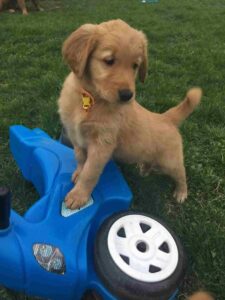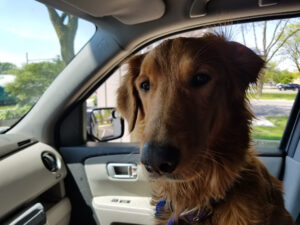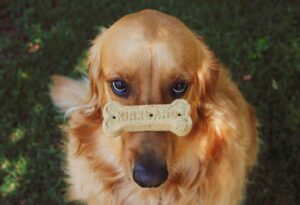Golden Retrievers are one of the most beloved dog breeds in the world, known for their friendly disposition, intelligence, and stunning golden coats. Whether you’re a proud owner of a Golden Retriever or considering bringing one into your family, it’s essential to provide them with the best care possible. In this comprehensive guide, we’ll walk you through everything you need to know about caring for your Golden Retriever, ensuring their health, happiness, and well-being.
Choosing Your Golden Retriever
These are the choices you need to make when you first decide to get a Golden.
- Adopt or Shop: Discuss the pros and cons of adopting from shelters versus buying from reputable breeders. There are many rescues available to get Golden Retrievers from. The problem is that they are staffed often with unpaid volunteers who don\t have good answers to many questions.
- Puppy or Adult Dog: Considerations when choosing between a puppy and an adult Golden Retriever. Adult Goldens are much more relaxed than puppies. While they do need regular exercise, they are not nearly as energetic as puppies.
- Health Checks: The importance of checking the dog’s health history and getting a vet’s opinion before bringing them home. Then, you’ll need to have a vet do a wellness check on your new family member including blood testing and the basic vaccines and medications.
Nutrition and Feeding
- Choosing the Right Diet: Explore the dietary needs of Golden Retrievers, including age-appropriate food, portion sizes, and special dietary requirements. The Golden Retrievers that I have had were all self regulating regarding food. I could keep food out for them and they would eat when they were hungry. They didn’t normally overeat and this made feeding time much easier on a daily basis. Try this but be sure they are not overeating and if they are limit their food.
- Healthy Treats: Recommend healthy treat options and stress the importance of moderation. Too many large treats can cause weight gain. You need to keep an eye on this. Overweight dogs have the same health problems that overweight humans do.
- Feeding Schedule: Establish a feeding schedule for consistency and optimal digestion.
Exercise and Activity
- Daily Exercise: Explain the breed’s need for regular exercise and the benefits of playtime and walks. This is extremely important, especially for puppies under 3 years of age. My Golden and I walk 6 to 8 miles per day. While she is older now, this has been such a benefit for me we still keep it up.
- Mental Stimulation: Discuss the importance of mental stimulation through toys, puzzles, and training. Dogs want to feel they are contributing to the families welfare. When they are trained to accomplish tasks to help mom or dad, they feel good about it and their mind stays active.
- Socialization: The role of socialization in your Golden Retriever’s development and behavior. It’s good to start with a training class, not only to have your pup behave better but also to get him around other dogs and people. Dog parks are great too but you do need to be careful of dogs who are aggressive and not properly trained.
Grooming and Coat Care
Brushing Routine
Brushing a Golden Retriever’s double coat is important to keep it healthy, clean, and free of mats and tangles. Here are some steps to follow: Use a pin brush or a slicker brush to gently brush the entire body, starting from the head and moving towards the tail. Brush in the direction of the hair growth, and avoid pulling or scratching the skin.
Use a metal comb to detangle the feathering behind the ears, chest, legs, and tail. Start from the end of the hair and work your way up to the skin. If you encounter a mat, hold it above the skin and carefully cut it out with scissors.
Use a rubber brush to remove any loose or dead hair from the undercoat. You can also back brush the fur to loosen it up before brushing it normally. Brush your Golden Retriever at least once a week, or more often during shedding seasons. You can also use a coat conditioner or spray to make the brushing easier and keep the coat shiny.
Bathing Guidelines
Bathing your Golden Retriever is a good way to keep their coat clean and healthy, but you need to do it properly to avoid any problems. Here are some tips on how to bathe your Golden Retriever:
Before you start, make sure you have all the supplies you need, such as towels, shampoo, brush, and treats. You can also use a blow dryer to help dry your dog faster and remove more loose hair.
Brush your dog’s fur before the bath to get rid of any dirt, mats, or tangles. This will make the washing easier and more effective.
Use lukewarm water to wet your dog’s coat thoroughly. Avoid getting water in their eyes or ears, as this can cause irritation or infection. You can use petroleum jelly or cotton balls to protect these areas.
Apply a mild dog shampoo to your dog’s fur and massage it into their skin. You can use a scrub brush or your fingers to work the shampoo into the coat. Avoid using human shampoo, as this can dry out your dog’s skin or cause allergic reactions.
Rinse your dog well with clean water until there is no soap left in their fur. Make sure you rinse the undercoat as well, as any leftover shampoo can cause itching or flaking.
Dry your dog with a towel or a blow dryer. If you use a blow dryer, set it on low heat and keep it at a safe distance from your dog’s skin. You can also brush your dog while drying them to remove more loose hair and make their coat fluffy.
Reward your dog with treats and praise for being a good boy or girl during the bath. You can also give them a toy or a chew to keep them busy while they dry.
Ear and Dental Care
Ear and dental hygiene are important aspects of your dog’s health and well-being. Here are some tips for maintaining them:
- For ear hygiene, you should check your dog’s ears regularly for any signs of dirt, wax, odor, or inflammation. You can use a cotton ball or gauze and a dog ear-cleaning solution to gently wipe the outer ear canal. Avoid using cotton-tipped swabs or anything with a pointed tip, as they can damage the ear or push debris deeper into the canal.
- For dental hygiene, you should brush your dog’s teeth at least once a week with a dog toothbrush and toothpaste. This will help prevent plaque buildup and tartar formation, which can lead to gum disease and tooth loss. You should also provide your dog with dental chews or toys that can help clean their teeth and massage their gums.
- In addition to home care, you should also schedule regular dental check-ups with your veterinarian. They can examine your dog’s mouth for any signs of dental problems, such as cavities, abscesses, or infections.
Health and Veterinary Care
Regular Vet Visits: Stress the importance of regular check-ups and communication with your veterinarian. I usually schedule veterinarian visits once a year if my pup is feeling well. The vet recommends the health needs at that time. Vaccinations and preventive care can be prescribed at that time. Things like vaccination schedules, flea and tick prevention, and heartworm protection can be worked out. Then, you can check on common health issues such as hip dysplasia and cancer, and how to recognize early signs.
Training and Obedience
One of the best ways to teach basic commands is to enroll your Golden in a puppy kindergarten. This will provide a specific time each week to spend with your pup. It will also help socialize your pup in dealing with both people and other dogs.
- Basic Commands: Teach basic commands like sit, stay, and come, and emphasize the importance of positive reinforcement.
- House Training: Tips for successful housebreaking and crate training.
- Behavioral Challenges: Address common behavioral issues and how to deal with them.
Safety and Traveling with Your Golden Retriever
Safety at Home: Creating a safe environment for your dog is an important part of responsible pet ownership. You want to make sure that your dog is protected from any potential hazards or dangers in your home and yard.
Here are some tips for creating a safe environment for your dog, including puppy-proofing: Remove or secure anything that can be chewed or swallowed by your dog, such as electrical cords, trash cans, small objects, sharp objects, medications, and products containing xylitol.
Limit your dog’s access to unattended areas where they could get into trouble, such as the kitchen, bathroom, laundry room, garage, or basement.
Check your houseplants and yard plants for toxicity. Some plants can be poisonous to dogs if eaten, such as lilies, azaleas, oleander, sago palm, and many more.
Provide your dog with a safe and comfortable space where they can rest and relax. You can use a crate, a bed, a mat, or a blanket to create a cozy spot for your dog. Give your dog plenty of safe and engaging toys to play with.
Toys can help your dog exercise their mind and body, prevent boredom and frustration, and satisfy their natural instincts. Choose toys that are appropriate for your dog’s size, age, and chewing style.
Protect your dog from fleas and ticks by using proper preventatives. Fleas and ticks can transmit diseases to your dog and cause skin irritation and infections. You can use topical treatments, oral medications, collars, or shampoos to prevent these parasites from infesting your dog.
Traveling Together: How to prepare for and enjoy road trips and vacations with your Golden Retriever. I travel with my Golden all over the USA. We drive from Ohio to Key West every year. Hotels are much more lenient today with pets than they have been in the past so that makes it a lot simpler. You’ll need to plan for bathroom breaks along with food and water.
Conclusion
Caring for a Golden Retriever is a rewarding experience that requires commitment, love, and knowledge. By following this comprehensive care guide, you’ll be well-equipped to provide your beloved companion with a happy and healthy life. Remember that every Golden Retriever is unique, so pay attention to their individual needs and always consult with a veterinarian for specific advice. Your Golden Retriever will reward your care and attention with loyalty and boundless affection for years to come. When I have my Golden with me walking or traveling, and I meet others who have, or have had Golden Retrievers, they invariably tell me how great the breed is. Check out Golden Retriever’s history and evolution.







1 comment for “How to Care for Your Golden Retriever: The Complete Guide for Your Furry Friend’s Well-Being”